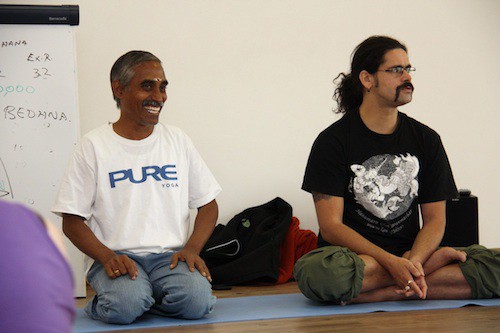Ilya Zhuravlev. Interview with Madhavan Munusamy
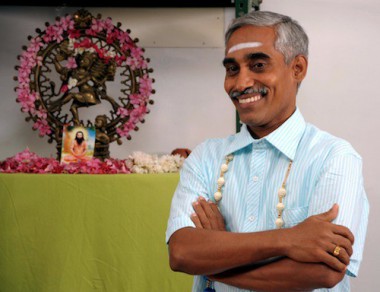
Dr. Madhavan Munusamy belongs to the South-Indian branch of Swami Sivananda tradition of yoga. Yogacharya Madavan is Bachelor of Ayurvedic Medicine and Surgery from Venkatramana Ayurvedic Medical College (Chennai); he also received a Post Graduate Diploma in Yoga Therapy from Vivekananda Yoga Anusandhana Samsthana in Bangalore and attended the Sivananda Yoga Vedanta ashram TTC and Advanced TTC courses. He was initiated by Swami Chidananda, a disciple of Swami Sivananda who currently runs Sivananda ashram in Rishikesh. While teaching, Dr. Madavan also follows Tirumandiram, the ancient sacred Tamil scripture. He was instructed in it by his father, who practises yoga and meditation throughout his life. Dr. Madavan’s Institute is registered by the Government of Tamil Nadu.
Yogacharya Madhavan is an expert in pranayama and yoga therapy, and his yoga students are frequent champions of International Yoga Festival run by Swami Gitananda ashram, Puducherry (Pondicherry).
Interview with Madhavan Munusamy
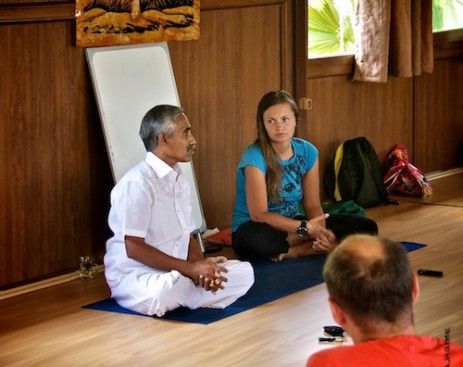
Ilya: How did you start your sadhana, how did you know about yoga?
Madhavan: My father was doing yoga, since he was at the age almost 30. I dont remember exactly how I started, but I remember that I saw how my father doing some asanas early in the morning, about 5 o`clock, i used to sleep in the bed, simply we were living only in one room that time, so i used to sleep under mosqito net and from mosqito net i saw he was doing asanas. I was at the age maybe 7 or 8. After he was going to office, and I was trying to repeat what he was doing. I just repeated him, that time he does not teach me. I was very much afraid of my father, he was strict, like most of fathers in India in those days. They wanted to make children more respectful and disciplined. So after he leaved for office, I tried to repeat headstand, that time we had beds with rope net, so I tried to do it on the bed, holding this ropes, an was falling back. Than I reach age of 13 or 14, my father ask me to do yoga practice, he show me some asans, started to teach me, he gave me books, and up to 16 I practiced asanas in my home town, Karur, than I went to Chennai, to study in Ayurvedic College. Than - college days, young boys, big city - sometimes I did practice, sometimes not. 6 years I was in Chennai - it was not regular yoga practice those days.
Ilya: What did you study in college?
Madhavan: Ayurvedic philosophy, ayurvedic diagnosis, ayurvedic treatment - everethyng based on Ayurveda. But we visited allopatic hospital to study anatomy and surgery. We saw the cases in allopatic clinic, but we did treatment with ayurvedic methods. After 1988 I completed my Graduation. In 1989 I was working in Erode in ayurvedic farmacy, we produced medicines - I was doing a lot of Chavanprash, different Lehyas, Arishtas, Churnas. In 1992 I stopped it and went back to my hometown Karur to start my own Ayurvedic practices. After two years of Ayurveda practices in 1994 I decided to do yoga therapy, I closed my clinic and went to Dehli to study yoga in Maharishi Foundation - that was my first thing to go to yogic field. Then a went back to Karur and after went to Bangalore to study yoga therapy course in Vivekananda Yoga Kendra, Government yoga-therapy Institute, which is called Vyasa University now. After completion I started my own yoga centre here. Up until 2000 every year I visited eminent yoga centres, such as Sivananda yoga ashram, Vivekananda Kendra, Divine Life Society etc. I completed TTC, ATTC and then Sadhana Intensive. I completed all Sivananda courses.
Ilya: You were staying in Rishikesh. Could you tell a little bit about your experience?
Madhavan: During my stay in Rishikesh I was undergoing the course called Intensive Yoga Vedanta, Far East Academy designed by Swami Sivananda himself. I stayed in Rishikesh for 3 months and was studying Upanishads, Bhagavad Gita, mantra chantings. Mostly like philosophical part of yoga and not much about practical things. The course concentrated a lot on bhakti, gyana yoga, karma yoga taught by Swami Chidananda and Swami Krishnananda.
Ilya: Was Swami Chidananda direct disciple of Swami Sivananda? Is he alive now?
Madhavan: Yes, he was direct disciple of Sivananda and head of Divine Life Society. Now, he is not alive, he reached mahasamadhi. I was initiated by him. It was a mantra initiation. Sivavananda Kutir near Uttarkashi was the only place he used to give initiations and where he enjoyed to take rest. I think I still have pictures of my initiations at that place.
Ilya: Do you remember this story that you`v once told me about one man who levitated in Rishikesh? Could you repeat this story for readers?
Madhavan: Yes, I remember this story. It happened when I was in Rishikesh. I saw a western person recovered from HIV with the help of yoga practices without allopatic medicine, by autoimmune system. He used only vichara, only self-witnessing, like yoga nidra that we give. I saw medical report proving that he truly had HIV. And also I witnessed a Southern Indian person in his 40-s, who levitated approximately 10 inches above the floor. He stayed up about 5 min and then slowly came down.
Ilya: It is very interesting, because there are so many people who don`t believe that it is somehow possible.
Madhavan: It is of course up to then whether to believe in it or not. Myself, I could hardly believe that person who recovered from HIV, even though he showed me all the medical reports. This person was an American millionaire who got HIV and couldn`t get a proper treatment in the US, so he went to Tibet where he lived for a month and not feeling any changes, he moved on to Delhi and then to Rishikesh. He told me a story about some beggar that came to him and taught some ordinary pranayamas like nadi shodhana, surya bhedana. He would eat and sleep and rest of the time just inhale, feeling how prana was going inside, multiplying and through the exhalation throw away all the ill cells from the body. Since he was a rich man he didn`t have to worry about the money but eating and sleeping. Whenever possible he was concentrating on the breath like this. Gradually he started to get the improvement and after 12 years he got cured and the blood samples showed no HIV cells.
Ilya: So, he spent 12 years in India?
Madhavan: Yes, and after he got cured he sold all the property in the US and started to lead a very simple life in India like a sadhu.
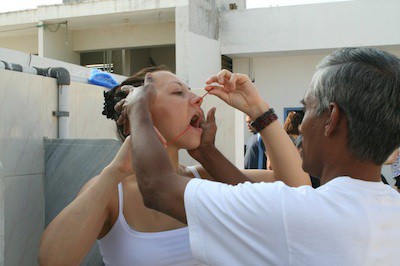
Ilya: Which are the most common diseases now in your city?
Madhavan: If you take like 10 years ago it was more of respiratory disorders, such as asthma because of textile industry that we have here in Karur. Now the policy on industrial pollution became stricter, the rate of respiratory disorders is slowly decreasing. Now it is a lot of back pain complaints, diabetes, cancer. Actually, I`ve got a cancer report of one of my patients, suffering from leukemia. After 8 months of treatment, regular pranayama practice, his state greatly improved. Im giving him amla fruit, which helped him a lot. He could even openly talk to other students that he was a cancer patient and that got cured. Before coming to me he used to undergo various anti-cancer treatments, such as chemotherapy and reports were always fluctuating – decreasing and improving from time to time, but after coming to yoga classes it started to improve steadily. He allows doctors, who cant`t understand his improvement to take his reports to their hospitals.
Ilya: In your teachings are you using knowledge received from different Yoga Institutes where you studied?
Madhavan: Not only from Institutes, but also from such scriptures like Tirumantiram, Tirukkural. At some point I asked myself why should I go somewhere in search for a knowledge if all wisdom is already written in these books. I started to read Tirumantiram, Tirukkural and other classical Tamil texts.
Ilya: Tirukkural is mostly moral prescriptions, whereas in Tirumantiram we can find prescriptions for yoga practices.
Madhavan: Yes, but what is yoga without moral? If you practice without moral, then yoga becomes a mere fitness. Mostly, in Western countries people practice yoga-fitness.
Ilya: The same situation can be seen in Asia. Nowadays, there are many yoga studios opening in Singapore, Honk-Kong…
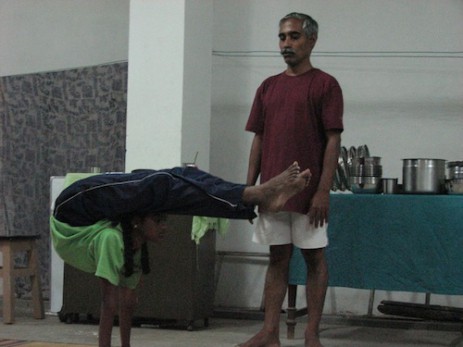
Madhavan: Yes, of course. Even in India in big cities yoga is taught on a fitness level. People don’t understand the real spiritual value of yoga, spiritual human personality, they just want to keep their bodies fit and healthy by means of yoga. First they come into yoga for health and only later they slowly start to understand the spiritual value of yoga. Out of 100 people may be only 2 or 3 think of the real value of yoga. It is the case even in India.
Ilya: But I think that even in ancient times there were not so many disciples of yoga, this knowledge was not so common. Even scriptures say that this knowledge was kept in secret. What is your opinion about the reasons of such secrecy?
Madhavan: Perhaps, these people didn’t want yogic practices to be changed or to protect from people with a wrong lifestyle, which could lead practitioners to certain complications. Such people would not accept their wrongs and would call yoga bad names. For instance, if after shatkarmas you go and eat chicken it would definitely do you wrong, but such people would not accept that eating chicken after kriya and not kriya itself harmed them.
Ilya: Yes, we got to a very important point here. A lot of Westerners take some practices without following the whole tradition and are trying to use yogic techniques without changing their lifestyle.
Madhavan: You see, in reality health and happiness is in our nature. Yoga is not like changing something in your life yoga is to bring back. We are not doing something new, we are merely bringing back. We are in a wrong part and yoga puts us in a right part and even better to say in a real part. Because of the hectic world the modern society is running after pleasures and after hitting and hitting ourselves we still don’t get it. That why mother-nature punishes us in so many ways - diseases, unsatisfactory, problems. The thing is, that happiness which received with material, impermanent things - is not permanent, only permanent things can bring permanent happiness. Changeable things cannot bring unchangeable pleasure. Nothing is permanent in this world and even knowing that we still keep looking for pleasure in changing world. With this basic knowledge we should try and live content with the life that we have. Of course, it doesn`t mean that we should stop working, it is our duty to work, but we are going to get is not in our hands.
Ilya: In Bhagavad Gita in chapter describing karma yoga it is written that one should not be attached to the fruits of one`s work so that new karma is not created. Could you speak a little bit about Tirumantiram, since it is not so well-known in the West. It is not a problem to find translations of Bhagavad Gita, Yoga Sutras, Hatha Yoga Pradipika, but only last year the Engish translation of Tirumantiram was published and it is still not widely spread even among those who are interested in Indian philosophy.
Madhavan: Tirumantiram is one of the ancient classical yogic texts, but Saiva people call it Tirumurai. In Tamil we have 12 Tirumurais, written by so many Tamil Saivite Saints such as Thiru-jnana, Appar, Sundarar and other Nayanmars. There were 63 Nayanmars and Tirumular, the author of Tirumantiram, was one of them and he was also one of the 18 Siddhars. Nayanmars are devotees of Shiva, bhakti-yogis. Siddhars practiced hatha-yoga, kundalini-yoga, raja-yoga, gyana-yoga. If you look at Siddhars`s texts they talk about Shakti, prana and everything but at the same time they don`t have acceptance of pujas, temple worshipping etc. They didn`t accept official religion. Shiva is inside you and no need to go to the temple. Try to use discrimination, like gyana, knowledge. However, Tirumantiram also says that Shiva is within you, jivatma and paramatma are not different. Tirumantiram contains everything, such as yamas, niyamas, it is the only Tamil text, which talks about Ashtanga Yoga.
Ilya: Is there any difference between yoga of Patanjali Yoga Sutras and yoga of Tirumantiram?
Madhavan: If you take yamas and niyamas, Patanjali describes 5 of each, whereas Tirumantiram gives 10. There are some mild differences, but nothing drastic. Tirumantiram describes chakras, gives regulations for disciple, for guru, but not so much about hatha yoga, practical aspects. Tirumuram talks about pranayamas, but mostly about final stages of pranayamas, about all the signs and symptoms, but not about the techniques of pranayamas.
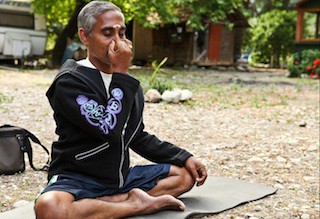
Ilya: There is a popular opinion that in ancient times people didn`t practice so many asanas, but just a few to prepare body for padmasana and raja yoga. What can you say about it?
Madhavan: Here we should talk about two streams of yoga - Yoga Sutras of Patanjali and Hatha Yoga tradition of middle ages. Patanjali talks about yoga-asana only in terms of «Sthira Sukham Asanam», only sitting meditative asana. So, in those days only meditative asanas were considered as asanas, which should lead us to samadhi.
Ilya: But did various postures and Surya Namaskar exist back then?
Madhavan: I can`t say for sure, because there are no evidences of Surya Namaskar in classic texts.
Ilya: A few mentions can be found in some Puranas, but of Surya mantras and not exercises.
Madhavan: Yes, 12 mantras are there, but not physical practice. However, Tirumantiram talk about hundreds and hundreds of asanas. The last verse of Tirumantiram ends with the mention of hundreds of other asanas, apart from meditative, but no names are given. The only asanas named, Simhasana, Padmasana, Bhadrasana - are mostly seating postures. Because, whatever classical, cultural asanas we do should lead us to meditation, because without meditation samadhi is impossible. So, the purpose of practicing so many asanas is to prepare our body to sit still for a long time in meditation.
Ilya: Yes, I believe that is what most of Western yoga studios lost, since they focus on physical aspects of asanas, forgetting what is the ultimate goal of such practices. However, nowadays we can see an increasing interest to spiritual side of yoga among the Westerners, people are getting interested in Indian philosophy, they are reading books, attending different lectures. Surprisingly, in India the interest is decreasing, it seems that the interest in yoga has moved from India to the West.
Madhavan: I agree. Of course, there are people who are very much into practice, but they are not well-known. There are Siddhars, but such people they want to practice for themselves, they don’t wish to get famous and to share their knowledge. The thing is, that being in a lower level, we can`t identify Siddhars, unless they decide to reveal, express themselves, but they still exist and live all around India. Such people are not chasing fame or money.
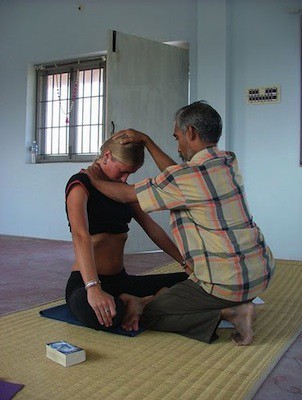
Ilya: Going back to your main field of speciality, what is common and what are the main differences between yoga-therapy and ayurveda. There are cases, when one or another worked better for a patient, could you, please, comment on it.
Madhavan: Both require a life style modification from a patient. As far as my personal practice concerns, ayurveda is more superficial, it is unable to cure unless one changes thoughts.
Ilya: Why here in India we can meet lots of ayurvedic doctors, who themselves don`t look healthy and are suffering from different diseases?
Madhavan: The answer is simple - for them ayurveda is merely a profession, a way to earn money. They are not necessarily living according ayurvedic rules.
Ilya: In my opinion, a good doctor should practice ayurvedic rules himself.
Madhavan: Well, there is no need to think of ayurvedic rules, if you want to live according to the laws of Nature. If you know and practice yamas and niyamas, then what is the purpose of ayurveda?
Ilya: But we need ayurveda to heal certain diseases or do you think that just by simply following all yamas and niyamas an illness can be cured?
Madhavan: I think practicing yamas and niyamas can change your karma, and ones karma is changed, everything can become different.
Ilya: However, there are stories of saints, who died of fatal diseases, like Svami Sivananda, Ramakrishna or Ramana Maharshi.
Madhavan: Yes, they accepted their karma.
Ilya: I believe such people followed all yamas and niyamas most of their lives or even entire life, like Ramana Maharshi, who was enlighten form his childhood, and yet he couldn`t change a certain part of his karma.
Madhavan: Yes, but the thing is that he didn`t want to change any part of karma, but wanted to undergo the sufferings meant for him, so that not to continue samskaras in the next birth. That is what he told in his books. He wanted to undergo the sufferings, so that not to carry them in his next birth.
Ilya: Yes, but various scriptures, even Yoga Sutras, say that yogi who attained dharma megha samadhi can burn his / her karma and will not take birth in material world again.
Madhavan: They are talking about a very advanced level. These are very high level books - Yoga Sutras Patanjali, Tirumantiram, texts of Ramalingam. Ramalingam was also a saint and he lived in Tamil Nadu, when India was still under British government. He wrote books and commentaries, but he mainly talked about meditation, siddhis, yamas, niyamas, he describes 4 topics: discipline for indriyas, for antahkarana, for life and for soul. An answer for any question can be found in this book, but we are not in the position to understand the way he explained, because he didn`t go to any school.
Ilya: Was he also enlighten since childhood, did he have any siddhis since he was a boy?
Madhavan: Yes, he started to talk about so many profound things at the age of 6-7.
Ilya: Such people are very rear.
Madhavan: Yes, we have only one Ramalingam, only one Tirumular.
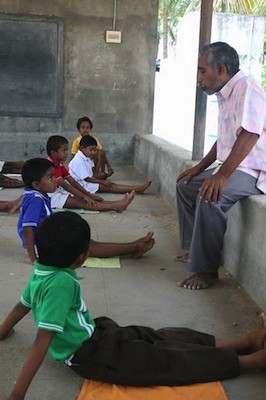
Ilya: I think that many people lack interest in spirituality because they don’t know the examples. It is especially true for the Westerners, who perhaps have never seen an enlighten person in their entire lives. Reading books is one, but meeting such enlighten person who achieved high levels of spirituality is absolutely another story.
Madhavan: So, if you don`t believe in those things, then you will never get such experience. Mother Nature, God test you how strong your belief is. If you totally believe in God, finally he will come and save you. He prepared so many tests for us and we need to be patient to undergo all the sufferings.
Ilya: Most people have trust only in scientific approach.
Madhavan: Yes, even Ramalingam wrote that he wanted to give his knowledge to people, but there was nobody to take it.
Ilya: In the West knowledge means always scientific approach, but in ancient Indian tradition only spiritual knowledge is true.
Madhavan: In Tamil we call it Arivu - spiritual knowledge, that which eradicates the cycle of birth and death. The knowledge to overcome death. The real education is that gives you immortality, all others are not real.
Ilya: In your opinion, in 100-200 years will spiritual tradition in India still exist?
Madhavan: It will exist, because it holds the truth and truth never dies. Even if there are no people there, it will come out somehow.
Ilya: So, future generations still have a chance. It is very interesting, because in order to get interest in spirituality, one should have certain experience, should overcome sufferings.
Madhavan: That is exactly what God gives us sufferings for.
Ilya: That is why rarely young people have deep interest in yoga, because they lack life experience. Mostly they are interested in the physical aspect of yoga.
Madhavan: Once the responsibility comes, sufferings begin.
Ilya: Let me ask you a final question, to bring us all down to the earth. If a person wishes to visit your centre, what subjects do you teach?
Madhavan: I can teach according to needs. I can not teach a high level to a very beginners and at the same time I can`t teach basic to someone on a high level, that is why whoever comes to me I ask what does the person want to learn. Students can study asanas, pranayamas, shatkarmas, philosophy, yoga-therapy.
Ilya: What is your opinion about different TTCs you participated in with your workshops?
Madhavan: I`v been many times to Honk-Kong, Singapore, Thailand, Russia. Comparing to others Russians are more advanced in terms of philosophy. I can not say for all people, but only for those who attended my workshops in Moscow. In other countries nobody knows anything about spiritual yoga, nobody is interested in it. Most of people who enrolled in TTC in Asia have never heard about Yoga Sutras. They are eating meat and fish which is violation of ahimsa, non-violence. Yoga practicioner defenitely should avoid it.
Ilya: Perhaps, after your lections some people read about it.
Madhavan: It is our duty to give knowledge, and it is up for them whether to take it or not. Our duty is to throw and they will catch according to their capacity, to their needs. That`s what I always tell to people. Even if it doesn`t come now, one should still be happy, because this is what possible now. But knowledge which you are giving by lections is like a borrowed, rented knowledge, it is never going to help if student are not ready.
Once there was a blind man, who was begging in the street and there was a social worker who wanted to help that beggar. So, he comes up to beggar and offers him to stay at his place for a few days. The beggar happily accepted the offer, and was staying at his place, eating, drinking, enjoying his life. On the third day beggar decided he wanted to leave. Social worker asked in surprise why the beggar wanted to leave, and the beggar replied that he couldn`t always stay among other people`s things because they could not help him. The social tried to talk him out of it saying that it was dark and advising to postpone it at least for tomorrow morning. The blind man started to laugh at, saying that he was already blind regardless to whether it was dark or light outside. Then the social worker offered him a lamp. The blind man didn`t understand what he needed that lamp for if he couldn’t see. The social worker explained that was for other people to see someone was coming, to recognize him and be cautious not to hit him. The blind man took the lamp, and while he was walking along the street someone banged him badly. The blind man started to shout if that stranger didn’t have eyes. The stranger answered in the affirmative. The blind man asked if he didn`t see the lamp. The stranger looked at the lamp but the light was off. He said that he could see the lamp but no light was there. So the blind man threw away the lamp and took out his own stick and continued walking as he always did. So, whatever knowledge we receive from other people it wouldn’t work for us unless we put it inside. I always say to people- whatever I`m telling you it is only an information which you can also get from books or internet, but until you don`t experience it wont become your knowledge. Knowledge is something experienced. You can get so many information but all information can`t become your knowledge.
Karur, Tamil Nadu, India, jan 2011
Yogacharya Madhavan will participate in Yoga-Rainbow Festival in Goa, India, 10-16 January 2012










